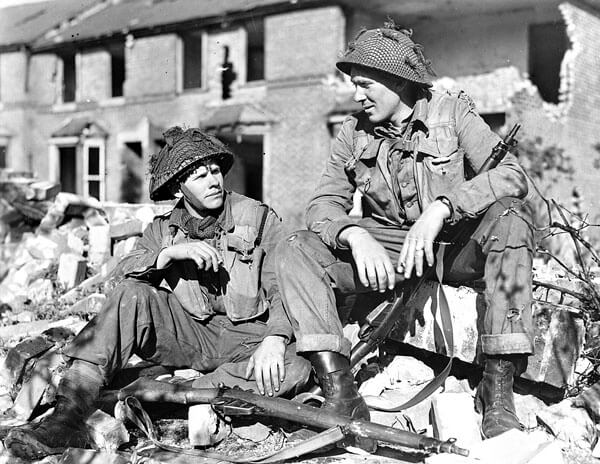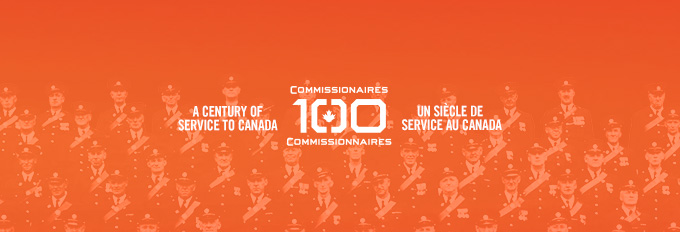
Members of The Canadian Scottish Regiment come ashore on Mike Green Beach at Courseulles, France, on D-Day.[DND/LAC]
Wayne Arnold’s war started on an early autumn day in 1943 somewhere on the North Atlantic, much sooner than he might have expected.
The Empress, Alta., native and thousands of other recruits were enjoying the summer-like warmth aboard the requisitioned Cunard liner Queen Elizabeth, four years out of the shipyards of Clydebank, Scotland, and three days out from Pier 21 in Halifax, when the ship’s alarm sounded.
It was 2:30 p.m. and Arnold, a corporal destined for the ranks of The Canadian Scottish Regiment, was on the sundeck basking in the company of about 200 nurses.
“I heard an order for ‘Full Left Rudder,” he related in a memoir. “They also shut one propeller off and opened full speed ahead on the right rudder. This huge boat seemed to pivot and really listed to the right.
“Looking down at the ocean, we saw two German torpedoes slowly passing by. They told us later that that was the 14th time the Elizabeth was fired on by U-boats and never was hit. On account of this situation, we detoured by Greenland as there was a pack of German subs loitering in the Atlantic Ocean.”
“Looking down at the ocean, we saw two German torpedoes slowly passing by.”
Three days later, the speedy troopship dropped anchor at Greenock, Scotland. It was four days before its uniformed passengers disembarked and on Oct. 6, the day before his 22nd birthday, Arnold headed south to join his new regiment.
The headstrong corporal didn’t get along with his new ‘D’ Company bosses, however, and so, in the spring of 1944, he requested a demotion to private and a move. With D-Day looming, he found his way into an anti-tank platoon.
On June 6, 1944, ‘A’ Company of The Canadian Scottish made the 10-kilometre, 90-minute run into Juno Beach aboard Landing Craft Assault, known as LCAs.
Taking up the rear of the 7th Brigade, 3rd Division, they disembarked about 40 metres from shore and waded chest-deep onto the beach under enemy mortar and machine-gun fire. By day’s end, they had made their way 10 kilometres inland, digging in and dispatching patrols.

The converted troopship Queen Elizabeth is loaded with American GIs for a wartime transatlantic crossing. [Earl of Cruise]
Arnold didn’t hit the beach until noon. The Royal Winnipeg Rifles and The Regina Rifles were in forward positions with the Canadian Scots back in reserve. Their objective was to cut and hold a Caen-Bayeux railway crossing at Putot-en-Bessin, a Normandy commune 20 kilometres from the beach that to this day is home to just some 400 people.
The Canadians took Putot-en-Bessin virtually unopposed on June 7. A Winnipeg patrol captured 19 prisoners.
The next day, however, 2nd Battalion, 26th Panzergrenadier Regiment, under SS-Obersturmbannführer Wilhelm Mohnke counterattacked, threatening a breakthrough to the beaches.
“Mohnke’s troops were openly disdainful of the heavy Canadian fire and just kept on coming, moving forward recklessly, arrogantly, inexorably,” wrote Second World War historian Howard Margolian in his book Conduct Unbecoming: The Story of the Murder of Canadian Prisoners of War in Normandy.
“Things got so bad that even the Winnipegs’ headquarters was under siege for part of the day.”
“By late morning, they were being supported by a battery of self-propelled artillery, which pummelled the Winnipegs’ positions under the weight of a thundering barrage,” wrote Margolian. “Still more difficulties ensued when the Germans successfully infiltrated a number of small parties into Putot itself.
“From strongholds in private homes and behind ruined buildings, the SS troops sniped at and rained down mortar shells on the Canadian positions, inflicting many casualties and wreaking havoc with the Winnipegs’ attempts to get more ammunition to their beleaguered forward units. Things got so bad that even the Winnipegs’ headquarters was under siege for part of the day.”
By noon, elements of the German 26th were taking prisoners. Canadian light-machine gun posts and slit trenches were under direct German artillery and mortar fire.
By 1:30 p.m., the Winnipegs’ ‘A,’ ‘B’ and ‘C’ companies were completely surrounded. Most of their automatic weapons had been knocked out and their ammunition was running low. Tank support was not readily available.
The beleaguered companies attempted to pull back under cover of artificial smoke, but few men escaped to battalion headquarters, due east of Putot, where the nearly intact ‘D’ Company had established a defensive position.

Captain Robert Seaborn, chaplain of the 1st Battalion, The Canadian Scottish Regiment, gives absolution to an unidentified soldier of the 3rd Canadian Infantry Division near Caen, France, on July 15, 1944. [Lieut. H. Gordon Aikman/DND/LAC/PA-142245]
No. 3 Platoon of The Cameron Highlanders of Ottawa, forward with their Vickers machine guns, was cut off in the fight. The platoon commander was captured and later escaped.
The Royal Winnipeg Rifles lost 256 men killed, wounded and missing—150, in fact, had been captured.
“I counted 18 members of the Winnipegs as they marched back through our ranks,” wrote Arnold.
More than 100 of the prisoners of war were turned over to German military police. Nearly 40 others, however, were sent to a farm in Putot, then on down the custody chain where they were marched under escort three kilometres to the regimental HQ.
At a road junction near Fontenay-le-Pesnel, the prisoners were herded into a grassy area and ordered to sit. At least two were on stretchers. An execution squad with machine pistols stepped up alongside the prisoner escorts; all turned their weapons on the Canadians and opened fire. Thirty-five were killed; five escaped.
An execution squad with machine pistols turned their weapons on the Canadians and opened fire.
Twenty-six other PoWs held by 3rd Battalion, 26th Panzergrenadier Regiment, were marched to Pavie for transfer to the 12th SS Division’s reconnaissance battalion. Included in the group were the officer commanding ‘A’ Company of the Winnipeg Rifles, 23 of his men, and two British soldiers captured at Brouay.
SS-Sturmbannführer Gerhard Bremer interrogated several men, gained no information and ordered them all summarily executed. “They were taken away in small groups for execution by gunshot,” said an account on canadiansoldiers.com. “The killings were interrupted by a British attack, but later resumed.
“All 23 men were eventually found murdered.”
On June 11, German troops captured a private of The Royal Winnipeg Rifles and two sappers of the Royal Canadian Engineers who had been out laying mines in front of Putot before the battle had begun. They had been separated from Canadian lines and spent three days surviving on emergency rations and stream water.
They were taken to the headquarters of the 26th Panzergrenadier Regiment and interrogated in the presence of Mohnke. “After the interrogation, the Canadians were marched a few yards from the regimental command post, had their identity tags stripped from them, were taken into nearby woods, and were shot at close range by a military policeman.”

Captains Albert Johnson and Gordon of the 1st Battalion, The Canadian Scottish Regiment, take part in a house-clearing training exercise in England on April 22, 1944. [Kenneth H. Hand/DND/LAC/PA-162246]
“Our Colonel, Freddie Cabledu didn’t wait for any orders,” wrote Arnold. “He formed up our Regiment and in two hours we recaptured the position the Winnipegs were knocked out from.”
The Canadians held out against a German counterattack, then retook Putot with the firepower of a tank squadron from the 1st Hussars and an artillery barrage from the 12th and 13th field regiments, Royal Canadian Artillery.
“At 2100 the left company was reported on the objective, and by 2130 brigade headquarters received reports the battalion was ‘mopping up,’” said the canadiansoldiers.com account. “While Putot itself was back in Canadian hands, never again to be occupied by the enemy, the line of the railway was yielded.”
Two days of fighting on June 8-9 cost the Canadian Scottish 125 casualties, 45 of them killed in action.
“The country side between the beach and Putot en Bessin was very much in ruins,” wrote Arnold. “From the bombing of aircraft, shell fire and mortar fire from our armada, it looked like a freshly plowed field.
“We stayed and held the fort for awhile.”
One quiet afternoon, Arnold’s platoon sergeant, Chuck Adams, looked at him and said: “Arnold, I always knew you had a yellow streak—just look at your arm.” Arnold looked and there was, indeed, a pencil-sized yellowish streak from his wrist to elbow.
“On examining my tunic, I found a square hole in the elbow. A bullet, on passing through woven cloth, leaves a square hole, so we knew then that a bullet was the culprit.”

Troops of The Canadian Scottish Regiment leave Europe the way many of them came, aboard the converted troopship Queen Elizabeth. [Pte. Floyd Watkins/Wikimedia]
Later, they moved up to Rots across the valley from Carpiquet airfield. They set up their gun pointing at the airfield, then found what was left of a shell-damaged house. “There was enough of it left to give us shelter so there we camped.”
While on guard duty at dawn one morning, Arnold spotted intermittent flashes coming from a bomb-damaged church steeple. He watched intently for a while, even waving off his relief.
“I…finally decided that this flash had to be a mirror in the hand of a German. The flashes were irregular, which gave me the idea of somebody sending a message. Also, following the series of flashes the mortars of the Germans, which we called Moaning Minnies, would be fired into our lines.
“Finally I drew a sight with my rifle and fired. I never saw any more flashes so decided to forget the situation. Later some intelligence people questioned me about there being a dead German soldier lying on the ground below the church steeple. I told them my story and they said that I got him square between the eyes.”
They also asked him if he knew the shot was more than 1,000 yards.
Eventually the airport was taken and the Canadian Scots headed for Caen. Arnold’s war was well underway. He would go on to Falaise, Calais, through Belgium and into the Netherlands before he was honourably discharged in 1946.
Back home, he married his eventual wife of 25 years, Bertha. They had six children. He farmed, practised woodworking and drove a truck for Canada Post.
Wayne Howard Arnold died on Oct. 15, 2004. He was 83.
Advertisement





















